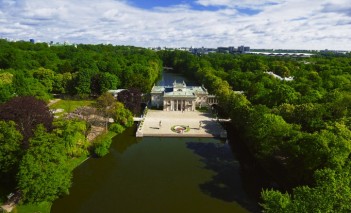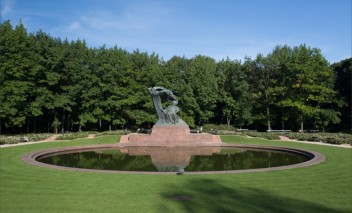The White Pavilion and the Water Tower will regain their past splendour. The project has received funding

The Royal Łazienki Museum has succeeded in obtaining funding for conservation and renovation works to be carried out in the White Pavilion and the Water Tower. The official signing of the agreement took place in the Ministry of Culture and National Heritage on 6 March 2017.
The agreement on the co-financing of the project ‘Sources of Transformations. Protection and Sharing of the Historic Heritage of the Royal Łazienki. Conservation and Renovation of the White Pavilion and the Water Tower Together with the Historic Garden of the Royal Łazienki Museum in Warsaw’ was signed by Professor Piotr Gliński, Deputy Prime Minister, Minister of Culture and National Heritage and Professor Zbigniew Wawer, Director of the Royal Łazienki Museum.
The Project is worth PLN 15 million, of which over PLN 9.7 million are funds granted by the Ministry of Culture from the European Regional Development Fund as part of the 2014-2020 Operational Programme ‘Infrastructure and Environment’; at the same time, PLN 2.4 million came from the Ministry of Culture and National Heritage.
The works in the Water Tower will start in September of 2017 and will last until May of 2018. In this period, the following elements of the building will be replaced: the roof covering, the wooden roof structure, the window and door woodwork, the internal stairs and the floors. The internal courtyard will be enhanced and the heating and electrical systems upgraded. In addition, the building will be adapted to the needs of disabled persons. As a result, the Water Tower will regain its former splendour and will house a new exhibition space.
The works in the White Pavilion will begin in November of 2017 and will last until March of 2019. Conservation work will cover the elevation, the windows, the interiors, the polychromes, the ceiling stucco, the floors, the mantelpieces and wooden decorations. The roof and the stairs will be repaired and the basements will be protected against moisture. A fire protection system and new sanitary installations will be added to the building, which will also be adapted to the needs of disabled visitors (induction loop, lift).
After the completion of the works, the entire building will be made open to visitors, who will have an opportunity to contemplate the new arrangements of the Royal apartments on the ground floor and the rooms on the first floor. Another attraction will be the innovative educational space.
The garden surrounding the White Pavilion will also be refurbished. The fountain will be renovated and the paths for visitors remodelled.
Conservation and renovation works to be carried out in the White Pavilion and the Water Tower constitute the next stage of the revitalization of the Royal Łazienki. This undertaking began in 2010, and since then, major buildings of the royal residence have regained their splendour: The Palace on the Isle, the Old Orangery, and the Myślewicki Palace. Conservation works have also been performed on precious collections of paintings, sculptures, and prints. A part of the Museum historic garden has also been refurbished. The total cost of the revitalization programme amounted to over PLN 130 million and was financed by – among others – the European Funds, the Norway Grants, the Ministry of Culture and National Heritage as well as the National Fund for Environmental Protection and Water Management.
Architectural testimony
The White Pavilion, the nearby Water Tower as well as the garden surrounding the two buildings constitute a unique testimony to the architectural legacy of Classicism and the Enlightenment. The White Pavilion was built between 1774 and 1776 according to a design by Domenico Merlini. It is the first Royal Łazienki building which was erected from the ground up on the order of Stanisław August. It belonged to the category of maisons de plaisance – suburban summer villas. The residence was associated with the women who occupied it at the time: the King’s sisters – Ludwika Zamoyska and Izabela Branicka, as well as Elżbieta Grabowska, who was – according to a legend – Stanisław August’s morganatic wife. Between 1801 and 1805, King Louis XVIII of France, who stayed in Poland during his exile, resided in the mansion.
The White Pavilion is a light structure, which harmoniously blends with the surrounding garden. The original wattle and daub structure of the walls on the first storey, the decoration of the elevation, and the historical décor of the 18th century interiors of the building have been preserved. Among the noteworthy items are the grotesques in the Dining Room painted by Jan Bogumił Plersch, which were the first painted decorations of this type in Poland, and the 18th century wallpapers in the Drawing Room, which include wallpapers imported from China and depicting European trading posts in Canton and scenes from Chinese people’s lives.
The Water Tower is a garden pavilion, which used to function as a water tank supplying water to the neighbouring buildings and fountains. It not only has a unique artistic value, but also a historical one – it is a testimony to technical solutions applied in the past. The Pavilion was built in the 17th century, in the times of the first owner of the Royal Łazienki, Stanisław Herakliusz Lubomirski. In 1777, it gained its characteristic, round shape, and in 1823 – owing to the architect Chrystian Piotr Aigner – a unique decorative appearance which alludes to the Roman tomb of Caecilia Metella. At present, the Water Tower partly fulfils its historical function by collecting water from the bottoms of the nearby hills.












